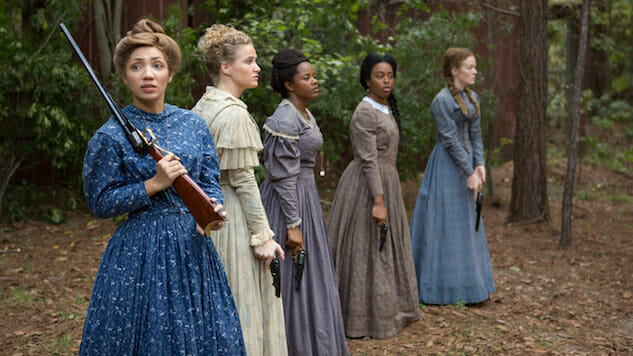How Underground Season Two Reinterprets History by “Blowing Up the World”
WGN America
Freedom was a community labor for something lovely and rare. — Colson Whitehead, The Underground Railroad
Underground’s second season scatters its characters to the four winds. Rosalee (Jurnee Smollett-Bell) joins forces with Harriet Tubman (the incandescent, slyly funny Aisha Hinds), outgunning white patrollers as their charges flee for freedom; her paramour, Noah (Aldis Hodge), awaits trial in an Ohio prison; her mother, Ernestine (Amirah Vann), sold away by a bitter mistress, sinks into opium addiction on one of South Carolina’s sea islands. In this, WGN America’s humane, engrossing melodrama—one with a fair helping of historical depth—charts much the same course as Whitehead’s novel, tracing the faint, far-flung connections from which freedom was haltingly, painfully, born. Though the season premiere, “Contraband,” is punctuated by urgent action, including Tubman’s memorable introduction (“My arms are mighty tired,” she says, a weapon in each hand, as the camera captures a confrontation with her pursuers. “And I aim to end this quick.”), Underground’s changing shape is no desperate attempt to attract our attention. In fact, for series co-creators Misha Green and Joe Pokaski, seeing the Underground Railroad as an intricate network, one that shaped the course of the nation, was part of the plan all along.
“We first talked about a five-season series,” Pokaski says of his initial conversations with Green. “The whole idea was that Season One was going to be about this journey North. Season Two was about blowing up the world.”
And piecing it back together, too: Where Underground’s freshman season focuses on “the Macon 7” as they plan and enact their escape from bondage, the series’ sophomore outing surveys the entire landscape, bringing in historical figures such as Tubman and Frederick Douglass (John Legend) to suggest the Underground Railroad’s place within the broader abolitionist movement. As Hinds explains, the goal was to move beyond mythic history, situating such iconic figures within the intimate lives of the series’ fictional protagonists.
“I sat down and wrote out all of the things that I knew about her and saw that the list was rather short,” Hinds says of her preparations to play Tubman. “I knew that she was a famed conductor of the Underground Railroad, but what it meant in terms of her humanity, that was the entry point I wanted to take on—understanding who she was as a human being.”
As Green points out, it’s not often noted that Tubman, Douglass, John Brown, and other activists of the antebellum era were correspondents and collaborators, building a movement brick by brick as surely as the organizers of the present. By intertwining multiple narrative threads, Underground Season Two dramatizes—and, with its modern music and fleet-footed camerawork, updates—the grassroots nature of this action, reclaiming the abolitionist mantle from the white, northern evangelicals with which it’s often associated. One of the most joyous moments in “Contraband,” for instance, comes as the members of a multiracial women’s “sewing circle,” led by a free black woman named Georgia (Jasika Nicole), set aside knitting needles for target practice. Underground is not, as Nicole says, “the same old slave narrative”: As with Whitehead’s The Underground Railroad, or Ben Winters’ novel Underground Airlines, both of which literalize the metaphorical stations and routes, it’s a necessary—if at times exaggerated—intervention in our collective ignorance.
“I grew up in Alabama, and I remember my textbook, reading literally a few sentences about slavery,” Nicole says. “In Alabama. That is so unreal to me… All the education that I got [about slavery] has been as an adult, on my own.”
-

-

-

-

-

-

-

-

-

-

-

-

-

-

-

-

-

-

-

-

-

-

-

-

-

-

-

-

-

-

-

-

-

-

-

-

-

-

-

-








































